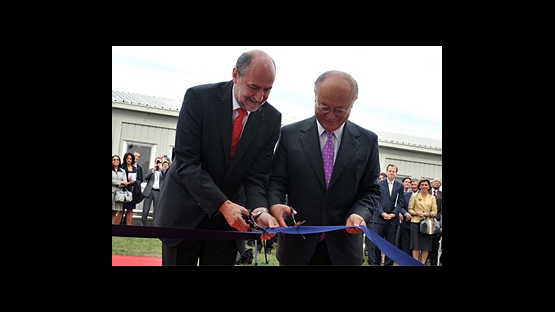The new Safeguards Clean Laboratory Extension, which provides the Department of Safeguards with vastly improved analytical capabilities to support the IAEA's verification activities, was officially opened by Director General Yukiya Amano on 7 September 2011.
The Director General has described the role played by the IAEA's Analytical Laboratories in safeguarding nuclear material around the world as "vital to upholding the integrity of the Nuclear Non-Proliferation Treaty."
The new Clean Laboratory Extension enhances the IAEA's independent nuclear analytical capacity and forensics capability, strengthening the Organization's ability to fulfil its role under the Nuclear Non-Proliferation Treaty, the world's most widely accepted non-proliferation agreement. As foreseen by the Treaty, the IAEA verifies that a State is living up to its commitment not to use peaceful nuclear programmes to make nuclear weapons.
Special Tools
To improve its ability to detect uranium and other isotopes in particles collected from environmental samples, the IAEA installed a new Large Geometry Secondary Ion Mass Spectrometer (LG-SIMS) in the Clean Laboratory Extension which is part of the Environmental Sample Laboratory located in Seibersdorf, Austria. The approximately €4 million investment is the centrepiece in the Laboratory's programme to ensure that its analytical capabilities can meet the challenges presented by the scientific and technical innovations expected over the next two decades.
In expressing his congratulations to the dignitaries gathered in Seibersdorf, the Chairman of the IAEA Board of Governors and Governor from Pakistan, Ansar Parvez, said, "We can be confident that the lab facilities already set up here - the extension being inaugurated to house the LG-SIMS - and the one for which ground is broken today and which will make available to the Agency state-of-the-art nuclear sample analysis capability by end 2014, will strengthen the overall quality of the Agency's safeguard efforts, and will contribute to the overall success of the ECAS project." The Chairman also noted that he was "particularly pleased to learn that the new Laboratory will also provide space for visiting scientists from Member States and serve as training facility for nuclear security professionals."
During the opening ceremony Amano said, "Since becoming Director General, I have made enhancing the Agency's analytical capabilities a high priority. The new LG-SIMS greatly improves the Agency's ability to independently analyse environmental samples for safeguards. In fact, it makes us a leader in particle analysis. This state of the art instrument, obtained thanks to the generous support of the Government of Japan, is now in routine operation supporting critical safeguards operations."
The new LG-SIMS is an instrument of unprecedented precision. Gabi Voigt, Director of the Office of Safeguards Analytical Services, says, "The laboratory has only just begun to determine the LG-SIMS' capacity for particle analysis, which has already proved to be much more versatile than we had expected. It assures us of faster, highly reliable results. We can do much more than ever before."
If human vision were as acute as the LG-SIMS, we would be able to sort through millions of objects in the asteroid belt to detect a single tennis ball. This level of resolution is needed when the Clean Laboratory Extension is analysing minute particles whose weight is measured in "femtograms". That unit is equivalent to a quadrillionth of a gram, roughly 10 000 times smaller than a grain of sand, or about the weight of a human cell. Such precise analysis allows forensic experts in Seibersdorf to determine a uranium isotope particle's distinctive fingerprint. Those clues then yield information about where it was mined, how it was processed and to which level of enrichment. That information is vitally important for the IAEA's inspectors when establishing the level of assurance that no undeclared nuclear activities have occurred at a particular facility.
The Laboratory's current mass spectrometer is almost 20 years old and is no longer reliable nor able to satisfy the demands placed upon it. The LG-SIMS can measure a sample within about two days, a welcome and necessary improvement in processing time.
Donors
The state-of-the art Clean Laboratory Extension, together with the LG-SIMS, represents a €9 million investment, which has been financed through the IAEA's regular budget, as well as voluntary contributions by Canada, Germany, Japan and the United States.
Nuclear Material Laboratory
Demand for analytical services is also growing at the IAEA's Nuclear Material Laboratory, at Seibersdorf. While the Clean Laboratory Extension provides assurance that no undeclared activities have occurred, the Nuclear Material Laboratory provides assurance that Member States are providing accurate information when they make declarations about the types and quantities of nuclear materials held on their territory.
"The new Laboratory will replace an aged facility dating back in part to 1976, which no longer meets the needs of the IAEA," said the Director General. "It will give us state of the art capabilities, including in the analysis of uranium, plutonium, spent fuel and high-activity liquid waste samples, as well as in archiving samples and analytical standards. It will have training facilities for inspectors and nuclear chemists, along with sufficient office space for the laboratory's staff and visiting scientists from Member States."
Currently, 800 samples are received each year for analysis. To use the available resources as effectively as possible, a new facility is being built, incorporating modern safety and security features. The new Nuclear Material Laboratory will assure productivity, while ensuring optimal working conditions, safety and security. Voigt says the new facility "will allow us to maintain our perfect safety and security record for many more years, while allowing us to provide excellent results and output."
Ground was broken on the site of the new Nuclear Material Laboratory on 7 September 2011. Construction, which will begin soon, is scheduled to be completed by 2014. Several Member States and organizations, including Canada, the Czech Republic, the European Commission, Germany, Ireland, Japan, the Republic of Korea, Spain and the United States, generously provided extrabudgetary contributions. Further voluntary contributions are being sought to complete this essential project.


